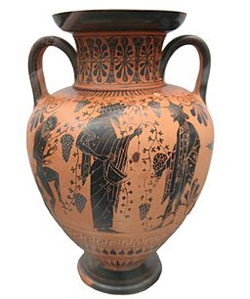Now that you have been introduced to the poetic term “metaphor,” read the next poem and see if you can discover several metaphors.

Source: Bricklayers at work, Neyland Stadium, Wyoming_Jackrabbit,
Flickr
To be of use
The people I love the best
jump into work head first
without dallying in the shallows
and swim off with sure strokes almost out of sight.
They seem to become natives of that element,
the black sleek heads of seals
bouncing like half-submerged balls.
I love people who harness themselves, an ox to a heavy cart,
who pull like water buffalo, with massive patience,
who strain in the mud and the muck to move things forward,
who do what has to be done, again and again.

Source: Greek vase Dionysos attica 520 bC,
MathhiasKabel, Wikimedia
I want to be with people who submerge
in the task, who go into the fields to harvest
and work in a row and pass the bags along,
who are not parlor generals and field deserters
but move in a common rhythm
when the food must come in or the fire be put out.
The work of the world is common as mud.
Botched, it smears the hands, crumbles to dust.
But the thing worth doing well done
has a shape that satisfies, clean and evident.
Greek amphoras for wine or oil,
Hopi vases that held corn, are put in museums
but you know they were made to be used.
The pitcher cries for water to carry
and a person for work that is real.
 This poem describes people who don’t mind working to accomplish a task, people who know that hard work has rewards. Let’s think more about this poem together. Use your notes to write responses to the four questions below. When you are finished with each question, check your understanding to see a possible response.
This poem describes people who don’t mind working to accomplish a task, people who know that hard work has rewards. Let’s think more about this poem together. Use your notes to write responses to the four questions below. When you are finished with each question, check your understanding to see a possible response. Start with the first stanza.
- What is the speaker comparing these people to, and what is the evidence from the poem that shows you this?
Sample Response:
The speaker is comparing people who work to swimming seals. She describes these people as “swimming with sure strokes” and says their heads are “bouncing like half-submerged balls.”
Now, look at stanza two.
- Write the comparison the speaker makes in this stanza. This time, however, try to figure out why the poet uses this metaphor. Ask yourself, “Why does the poet not compare hardworking people to some other type of animal such as a cat?”
Sample Response:
The speaker compares people who work to both an ox pulling a “heavy cart” and to a water buffalo that will “strain in the mud and the muck to move things forward.” The poet uses these two animals because of their strength and size. The animals are hard workers that will toil until they get the job done.
Let’s examine the third stanza.
- Here, the poet abandons the animals she has been using as metaphors and instead talks about people. The speaker says she wants to be with people who are “not parlor generals and field deserters.” Explain why you think the poet uses these metaphors.
Sample Response:
A general who sits in a parlor, or living room, instead of doing his duty in wartime, is an example of someone who does not perform his task. A deserter is someone who runs away from his task. The poet uses these metaphors to illustrate that these are the types of people the speaker does not want to be like.
Now, examine the last two lines of the poem.
- The speaker compares a person who wants and needs to work to what object? Why do you think this metaphor is effective?
Sample Responses:
The speaker compares people who are useful to a pitcher that carries water. She says the pitcher “cries for water to carry” since that’s what a pitcher is meant to do. Similarly, she believes that people want to do the work they are intended to do, “work that is real.”
As you read through poems, look for interesting comparisons a poet might make between two dissimilar people or objects. Metaphors often draw us into poems as we read.